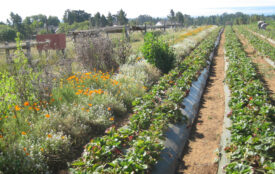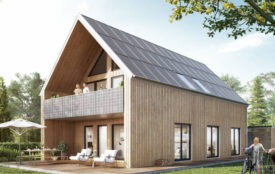Chbar Chros: outlook of the first solar village and mobile payment system of Cambodia
In Cambodia, where according to the Cambodian Ministry of Mines and Energy (MME), only 55% had access to electricity in 2015, developing the electrification of rural areas is a huge task, which requires, from the involved stakeholders, innovative methods and solutions.
The experience lead in 2015 by the Stiftung Solarenergie and its local partners, which consisted in electrifying a whole village with solar and in introducing a mobile payment system, SunControl-Payment-System, to traditional Solar Home Systems (SHS), is a shining example of a path to pursue.
This “Solar Village” concept, first introduced by Stiftung Solarenergie foundation in 2004 in Ethiopia and then replicated 4 times in Africa & Asia, aims at showing that, through the sustainable solarization of an entire village (households, public buildings and areas..), decentralized solar technology is able to foster economic and social development. To ensure the long-term success and contribution towards alleviating poverty of such projects, the foundation approach usually consists in partnering, defining and implementing the project with like minded local partners also striving for the sustainability of their actions. In the case of Cambodia, these actors were as followed:
- NRG Solutions, a Cambodian social enterprise providing sustainable and affordable energy to rural areas while focusing on both quality solutions and reliable after sales services. For this first Cambodian Solar Village, NRG is playing the role of the local installer, the trainer and the one in charge of after sales service;
- Camkids, a Cambodian NGO helping children in Cambodia who are either poor or whose parents are not there for them. Their modus operandi consists of focusing on understanding the needs of a few communities and identifying how to integrate, in a holistic way, long term solutions within these communities. Chbar Chros village in Kampong Speu was selected for this Solar Village because of Camkids long term involvement and trust with the community.
- Sevea, a Cambodian consulting company offering strategic and operational support to Corporations, Organizations, Projects & Social Entrepreneurs that seek to develop their impact strategies in the Water & Energy sector and/or engage with BOP markets. In this project, Sevea has been in charge of defining an appropriate methodology for the monitoring, evaluation and impact assessment of the solarisation of the entire community.
In order to follow the impact of such a project, Sevea conducted, prior to the installation of the solar systems, an initial exhaustive assessment to understand the electric situation of the village of Chbar Chros. Following is an overview of this initial situation:
Similarly to many Cambodian villages, Chbar Chros will not be connected to the grid before a few years. Most of the households of the village were considered as a Tier 1 on the Energy ladder of Sustainable Energy for All, the lowest level in terms of access to electricity supply. This meant that the households had access to a basic source of light and a phone charger but no general lighting, TV and fan. For their electricity supply, households were using car batteries to power around 2 fix lighting bulbs in the house and a mobile charger. These batteries had to be charged in average once per week taking around 1.3 hours per recharge to those in charge of it.
In addition to “fix lighting solutions”, 90% of the villagers were also using electrical mobile lanterns to walk in the village or for their fishing activities. Dry cell batteries used to power these torches, needed to be changed very week and were usually, once used, thrown away around the houses or in the forest.
On the community level, 3 public infrastructures (the school, an accommodation for the staff of Camkids and a clinic) were already powered by reliable energy, since Camkids had identified this need as an urgent one and had started solarizing the buildings in 2013.
First positive feedbacks have not been slow to arrive: Just a few weeks after the official launch of the projects and the installations of the solar systems, families could just not stop to explain what an improvement it was for the village to have this project; not only with regards to the expanded possibilities to work in the evening or early in the morning but also thanks to the fact that the very time-consuming transport of the car batteries to the charging station is no longer necessary. In addition, they mentioned that they were particularly happy with the quality of the trouble shooting services, rarely seen in such villages.
As one of the objective of the Solar Village project is to be in a position to really follow-up and understand these outcomes, Sevea will conduct two more assessments, one after 6 months and one after a year. This thorough process of impacts measurement will give a more accurate idea about what the solarization of such rural area villages can bring in term of economic and social development. Furthermore, this project will provide first feedbacks about the advantages and disadvantages of the usage of mobile payment technologies in Cambodia.
- Impact assessment February 2016: Download here.
- Sevea supports entrepreneurs and organisations to build and scale sustainable solutions leading to social, environmental and economic impacts.










